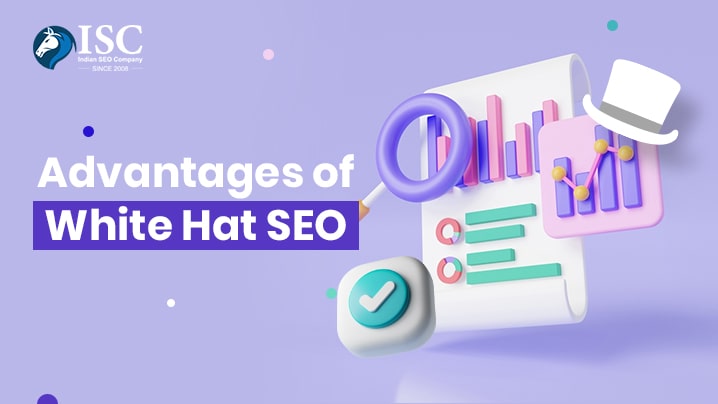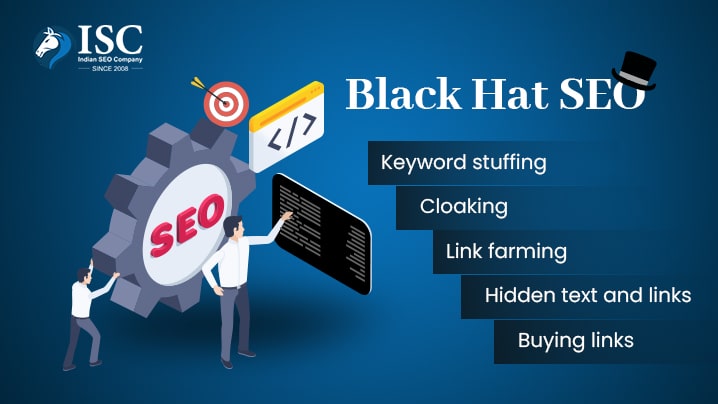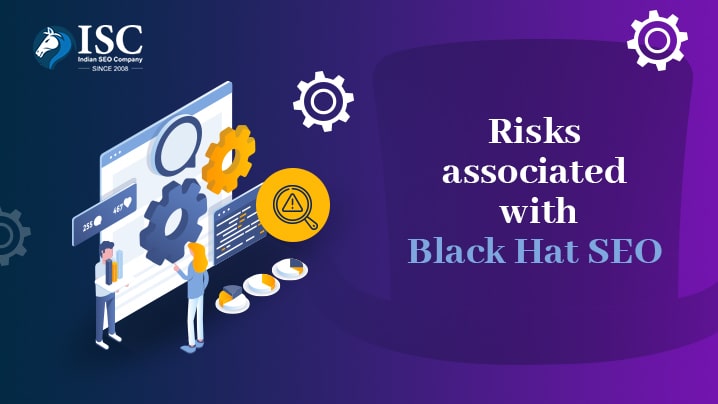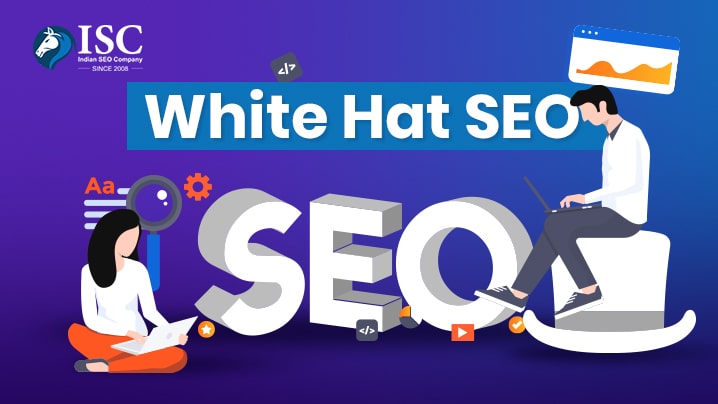Discover the differences between white hat and black hat SEO tactics and learn which approach is more effective. Get the inside scoop on optimizing your site for search engines.
Table of Content
1. Introduction
SEO, or search engine optimization, raises your website’s visibility in search engines. Think of it like getting ready for a first date with Google – you want to look your best, so they pick you over all the other websites.
Why is this important, you may ask? Imagine being lost in a big city and looking for a specific restaurant. You pull out your trusty smartphone and type in “best pizza in town.” Like a helpful friend, the search engine shows you a list of options. Now imagine your website is one of those options showing up on the first page of search results. More likely than not, people will click on your website; voila, you have some potential customers.
B. Brief overview of the two approaches to SEO: White Hat and Black Hat
There are different approaches to SEO. The White Hat approach follows all the rules laid down by Google to rank their website organically. On the other hand, in the black hat approach, you use shortcuts to improve the rank of your website.
White hat SEO is concerned with producing high-quality content and establishing natural backlinks. In contrast, black hat SEO often uses unethical techniques like keyword stuffing and link buying to manipulate search engine rankings.
2. White Hat SEO
A. Definition of White Hat SEO
White Hat SEO is the ethical and long-term method of optimizing a website for search engines. This approach complies with search engine guidelines and focuses on providing a positive user experience. White hat SEO techniques include:
- Creating high-quality, informative, relevant content.
- Conduct thorough keyword research.
- Optimizing website structure and meta tags.
- Building backlinks from reputable sources.
This approach is designed to improve the overall visibility of a website in search engine results without resorting to manipulative or unethical tactics that can result in penalties or bans from search engines.
B. Best practices for White Hat SEO
1. Quality content creation
Quality content creation is a fundamental aspect of white hat SEO. It refers to creating informative, engaging, and valuable content that appeals to search engines and users. This includes blog posts, articles, product descriptions, videos, infographics, and more. Quality content should be well-researched, well-written, and free of errors. It should provide value to the user, answer their queries, and help them make informed decisions. It should also be optimized for the target keywords and include meta tags and internal linking for better search engine visibility.
2. Keyword research and optimization
Keyword research and optimization identify the terms and phrases users search for when looking for a product or service like yours and incorporate them into your website’s content and meta tags. This assists search engines in comprehending the usefulness and context of your website and improves its visibility in search results.
Effective keyword research involves identifying high-volume, low-competition keywords relevant to your business and target audience. It also includes understanding the user intent behind those keywords and creating content that addresses those needs.
3. Building backlinks naturally
Building backlinks means getting other websites to link to your website. These links act as endorsements and signal to search engines that your website is valuable and authoritative. However, not all backlinks are created equal. Backlinks from high-quality, reputable websites carry more weight than those from low-quality or spammy websites.
White Hat SEO focuses on building backlinks naturally by creating valuable and shareable content, participating in online communities and forums, and reaching out to other websites and asking for a link. This approach is more sustainable and less risky than black hat tactics such as buying links or participating in link farms.
4. Optimizing for user experience
Optimizing for user experience, also known as UX optimization, ensures that your website is easy to navigate, visually appealing, and provides a positive experience for the user. This is important for SEO because search engines consider user experience a ranking factor. A website with a poor user experience is less likely to rank well in search results.
UX optimization includes website design and layout, page speed, mobile responsiveness, and ease of navigation. It also includes providing clear and valuable information, easy-to-use forms, and calls to action, and minimizing distractions such as pop-ups and ads.
5. Keeping up with algorithm updates and changes
Keeping up with algorithm updates and changes is an essential aspect of white hat SEO as it helps you understand how search engines rank websites and what they consider crucial factors. Search engines like Google constantly update their algorithms to improve search result quality and penalize websites that use manipulative or unethical tactics.
Failing to keep up with algorithm updates can result in a website being penalized or even banned from search results. Therefore, it is crucial to stay informed about the latest updates and changes to search engine algorithms and adapt your SEO strategy accordingly.
There are several ways to stay informed about algorithm updates, such as following the official blog of search engines, subscribing to industry publications, and attending SEO conferences and events.
C. Advantages of White Hat SEO

1. Long-term success
One of the most important benefits of using White Hat SEO techniques is long-term success. Unlike black hat SEO, which focuses on quick and easy ways to manipulate search engine rankings, white hat SEO is designed to create sustainable and lasting results.
White Hat SEO provides value to users and search engines by creating high-quality and informative content, optimizing website structure, and building backlinks from reputable sources. These efforts improve the website’s visibility in search results, establish it as an authority in its niche, and build trust and credibility with users.
White Hat SEO also helps create a better user experience, improve the website’s conversion rate, and generate more leads and sales.
2. Compliance with search engine guidelines
Another significant benefit of white hat SEO is compliance with search engine guidelines. Google and other search engines have strict guidelines in place to ensure that search results are of high quality and relevant to users. A website’s visibility and ranking in search results can be improved by adhering to these guidelines.
White Hat SEO techniques, such as creating quality content, conducting thorough keyword research, and naturally building backlinks, are all in compliance with search engine guidelines. This approach ensures that a website is not penalized or banned for using manipulative or unethical tactics.
Adhering to the search engine guidelines improves the website’s visibility in search results and enhances the user experience, generating more leads, sales, and loyal customers.
3. Increased trust and credibility
By providing valuable and informative content, adhering to search engine guidelines, and focusing on a positive user experience, a website can establish itself as a reliable and trustworthy source of knowledge in its field.
White Hat SEO techniques, such as creating high-quality content, participating in online communities and forums, and building backlinks from reputable sources, all contribute to building trust and credibility.
When users find that a website provides valuable and accurate information, they are more likely to return to the website, recommend it to others, and make a purchase. Additionally, by providing a good user experience, a website can increase the likelihood of users staying on the website for longer, reducing the bounce rate and increasing engagement.
Furthermore, having a credible and trustworthy website is also beneficial for businesses, as it can help increase brand loyalty and customer retention and ultimately generate more sales.
4. Better website traffic and conversions
Better website traffic and conversions are some of the most tangible benefits of using White Hat SEO techniques. By creating high-quality, informative, and relevant content, optimizing website structure, and building backlinks naturally, a website can improve its visibility in search results. This results in more users finding and visiting the website, increasing website traffic.
Additionally, by providing a good user experience, a website can increase the likelihood of users staying on the website for longer, reducing the bounce rate and increasing engagement. This can lead to more users taking desired actions on the website, such as filling out a form, making a purchase, or signing up for a newsletter.
3. Black Hat SEO

A. Definition of Black Hat SEO
The unethical and manipulative approach to optimizing a website for search engines is known as black hat SEO. This approach violates search engine guidelines and focuses on tricking search engines into ranking a website higher in search results. Black hat SEO techniques include manipulative tactics such as keyword stuffing, cloaking, link farming, hidden text, buying links, and more.
These techniques artificially inflate a website’s rankings and drive more traffic. However, this approach is not sustainable and can result in severe penalties or even a ban from search engines. It can also result in a poor user experience, damaging the brand’s reputation and decreasing the website’s conversion rate.
B. Common techniques used in Black Hat SEO
1. Keyword stuffing
Keyword stuffing is a Black Hat SEO technique that involves cramming a webpage with an excessive number of keywords in an attempt to manipulate search engine rankings. This is done by including keywords unnaturally and excessively in a webpage’s meta tags, headings, and body content.
The goal of keyword stuffing is to make a webpage appear more relevant to search engines for a particular keyword or phrase. However, this technique violates search engine guidelines and can result in penalties or a ban from search engines. It can also make a website look spammy, damaging the brand’s reputation.
2. Cloaking
Cloaking is a black hat method used in search engine optimization (SEO) to deceive search engines and users by showing different content to each. It is considered a violation of search engine guidelines and can result in penalties or even a ban from the search engine.
There are two types of cloaking:
- IP delivery cloaking shows different content to users based on their IP address or location.
- User-agent cloaking offers different content to users based on their browser or device.
Both types of cloaking are used to manipulate search engine rankings and deceive users. They are considered unethical and may result in severe penalties or a complete ban from search engines. It is advisable to avoid using cloaking in any form.
3. Link farming
Link farming is commonly used in black hat SEO, which involves creating low-quality or irrelevant links to boost a website’s search engine ranking artificially. This strategy aims to trick search engines into thinking that a website is more relevant and vital than it actually is. However, search engines have become increasingly sophisticated at detecting and penalizing this tactic, making it an ineffective and potentially damaging strategy for improving a website’s visibility.
4. Hidden text and links
Hidden text and links are other tactics commonly used in black hat SEO. This involves hiding text or links on a website, typically using the same color as the background, or making the text exceedingly small. This strategy aims to embed keywords or links on a website to artificially boost the search engine ranking. However, like link farming, search engines have become increasingly sophisticated in detecting and penalizing this tactic, making it an ineffective and potentially damaging strategy for improving a website’s visibility.
5. Buying links
Buying links is another black hat SEO tactic that artificially boosts a website’s search engine ranking. This involves paying for links from other websites, which can be a quick way to acquire a large number of backlinks. Search engines consider paid links as manipulation of their ranking algorithms, which is unethical and leads to penalties, such as de-indexing a website from search results.
C. Risks associated with Black Hat SEO

1. Penalties and bans from search engines
One of the most severe dangers of black hat SEO is the possibility of penalties and bans from search engines. Search engines have become increasingly sophisticated in detecting and penalizing manipulative and unethical tactics. Websites that engage in black hat SEO risk being penalized or even banned from search results altogether. This can devastate a website’s visibility and traffic, making it difficult for potential customers to find the website and for the business to achieve its online goals.
2. Loss of credibility and trust
Another risk of black hat SEO is the loss of credibility and trust. When a website uses manipulative tactics to boost its search engine ranking, it can damage its reputation and make it difficult for customers to trust the website or the business. This can lead to a loss of customers, a fall in revenue, and a reduction in the website’s total worth.
3. Damage to brand reputation
Black hat SEO can also damage a brand’s reputation, as it can be associated with spammy, untrustworthy, or unethical behavior. This can lead to a loss of customers, negative reviews, and a decline in overall brand value.
4. Decrease in website traffic and conversions
Finally, black hat SEO can lead to a decrease in website traffic and conversions. When a website is penalized or banned from search results, it can be difficult for potential customers to find the website, leading to a decline in traffic and conversions. Additionally, if a website’s reputation is damaged, it can be difficult for customers to trust it and make a purchase, leading to a decline in conversions.
4. Comparison of White Hat and Black Hat SEO
A. Comparison of the two approaches in terms of effectiveness:
White hat SEO optimizes a website that adheres to search engine guidelines and best practices. It involves creating high-quality, relevant content and building natural, organic backlinks. This approach is considered effective in the long term, as it helps establish a website’s reputation, credibility, and trustworthiness. White hat SEO can take longer to see results, but it will be sustainable, and search engines will be less likely to penalize the website.
On the other hand, black hat SEO is a method of website optimization that uses manipulative and unethical tactics to boost search engine rankings artificially. These tactics include buying links, link farming, hiding text and links, and other manipulative practices. This approach is considered less effective in the long term, as it can lead to penalties and bans from search engines and a loss of credibility and trust. Black hat SEO can show quick results, but it is not sustainable, and the website is more likely to be penalized by search engines.
B. Comparison of the two approaches in terms of risks and rewards:
White hat SEO carries fewer risks and more rewards. The risks associated with this approach are minimal, as it adheres to search engine guidelines and best practices. On the other hand, the rewards include improved search engine rankings, increased website traffic and conversions, and a better reputation and credibility.
Black hat SEO, on the other hand, carries more risks and fewer rewards. The risks associated with this approach include penalties and bans from search engines, loss of credibility and trust, damage to brand reputation, and a decrease in website traffic and conversions. The rewards, if any, would be limited to short-term and temporary gains in search engine ranking.
Conclusion
In conclusion, while both white hat and black hat SEO can help improve a website’s search engine ranking, the former is more sustainable and ethical. Conversely, black hat SEO carries more risks and fewer rewards. For long-term sustainable growth of your website, it is always recommended to use a white-hat SEO approach.


 February 8, 2023
February 8, 2023



















